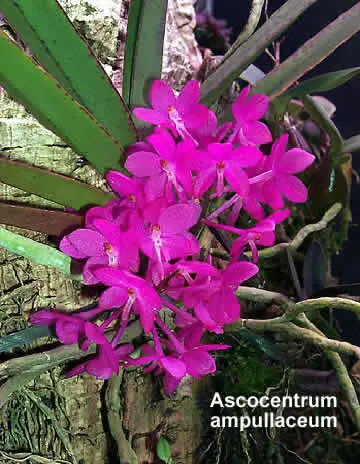 |
||
| Ascocentrum Around 10 species are known extending from India & Nepal to Borneo, the Philippines & Taiwan. They typically have yellow orange or red flowers on dense upright racemes. They prefer intermediate temperatures and bright light. |
||
| Ascocentrum ampullaceum From Nepal down to Thailand, this species is very floriferous. Dense racemes of pink flowers appear from the base of the plant in spring. Plant in pots, or on a slab. |
||
| /\ Top of Page | ||
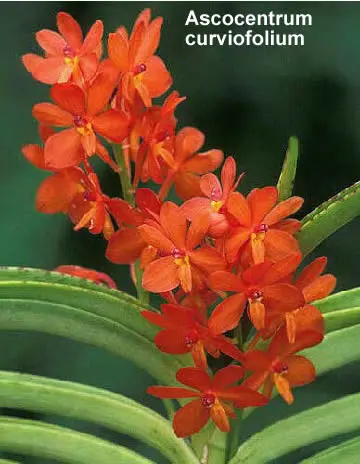 |
||
| Ascocentrum Around 10 species are known extending from India & Nepal to Borneo, the Philippines & Taiwan. They typically have yellow orange or red flowers on dense upright racemes. They prefer intermediate temperatures and bright light. |
||
| Ascocentrum curvifolium A native of Burma, Thailand and Laos, this species is one of the largest of the genus, and a favourite for hybridising with Vandas (Ascocenda). Upright racemes of orange flowers appear in late spring/early summer. |
||
| /\ Top of Page | ||
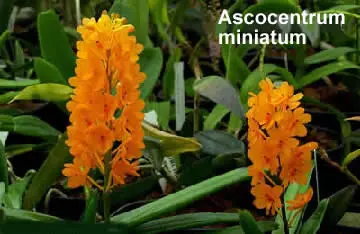 |
||
| Ascocentrum Around 10 species are known extending from India & Nepal to Borneo, the Philippines & Taiwan. They typically have yellow orange or red flowers on dense upright racemes. They prefer intermediate temperatures and bright light. |
||
| Ascocentrum miniatum x Doritis pulcherrima This plant produces 8 to 10 inch spikes of bright peachy orange flowers up to an inch and a half in size. The flowers last from 2-3 months and are usually produced in late winter to early spring. |
||
| /\ Top of Page | ||
| Ascocentrum Around 10 species are known extending from India & Nepal to Borneo, the Philippines & Taiwan. They typically have yellow orange or red flowers on dense upright racemes. They prefer intermediate temperatures and bright light. |
||
| Ascofinetia cherry blossom This is a hybrid crossing Ascocentrum with Neofinetia. This cross produces a very vigorous little plant and the flowers have a slightly sweet fragrance. |
||
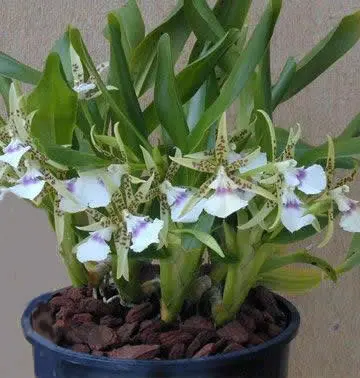 |
||
| Aspasia There are 8 genus of this South American species. They are epiphytic in tropical lowland forests and they have long flattened bifoliate pseudobulbs. The flowers are large and showy and are easily cultivated in intermediate conditions. |
||
| Aspasia lunata From spring to summer, one or two inflorescents emerged from the base of the 6 cm thick pseudobulb and each carry up to twelve 4 cm flowers. The pseudobulbs are 18 cm high and carry on their top two distichous, bracteole leaves about 30 cm long. The species is easily cultivated |
||
| /\ Top of Page | ||
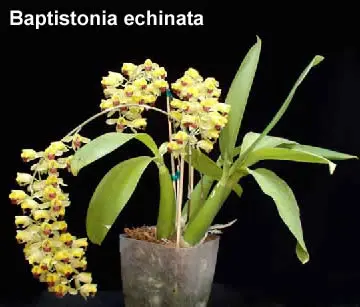 |
||
| Baptistonia is in the Oncidium alliance and has only one species. Native to Brazil, baptistonia's habit is similar to that of an oncidium, with compressed, oblong pseudobulbs topped with two coriaceous leaves and an inflorescence that arises from the side of a mature pseudobulb |
||
| Baptistonia echinata This is a small epiphyte, flowering in late winter. The yellow with light brown bars flowers are relatively small but with many flowers per inflorescence, the lip is bright yellow with a deep reddish maroon mid lobe. The flowers last about a month. The orchid like to be kept humid, with moderate shade and frequent watering year round with less water after the pseudobulbs fully mature. |
||
| /\ Top of Page | ||
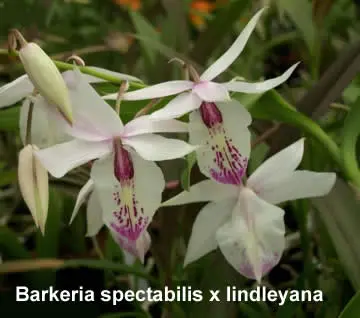 |
||
| Barkeria
A genus of 15 species from the Americas, from Mexico in the north to Panama. They have branching cane like stems and flowers of pink and white. They live as epiphytes in the forest and are easily cultivated at intermediate temperatures. |
||
| Barkeria spectabilis x lindleyana A primary hybrid of two of the Barkeria species. |
||
| /\ Top of Page | ||
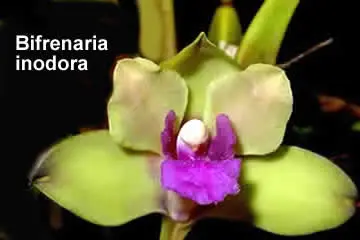 |
||
| Bifrenaria A genus of 24 species from South America. They are epiphytic from the wet tropical forests of Brazil. They prefer intermediate conditions |
||
| Bifrenaria inodora Pseudobulbous plant with one large apical leaf. One or two 6cm flowers which are waxy and long lasting. Grow in intermediate conditions, and do not let the plant dry out. |
||
| /\ Top of Page | ||
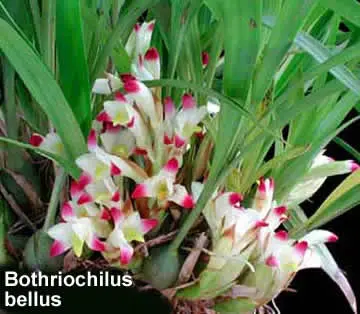 |
||
| Coelia
A south american genus containing 5 very showy species, found from Mexico down to Panama and the West Indies. Ephiphytes, these have round pseudobulbs with several leaves. The flowers arise in racemes from the base. Grow in intermediate temperatures, and keep evenly moist during the growing season. |
||
| Bothriochilus bellus Re-assigned as Coelia bellus an epiphytic orchid with lance-shaped leaves, to 45 cm long, and olive-green pseudobulbs. The bell-shaped flowers appear on short racemes, in early summer. Use epiphytic orchid potting mix in containers. Requires filtered light and high humidity in summer, full light and less water in winter |
||
| /\ Top of Page | ||
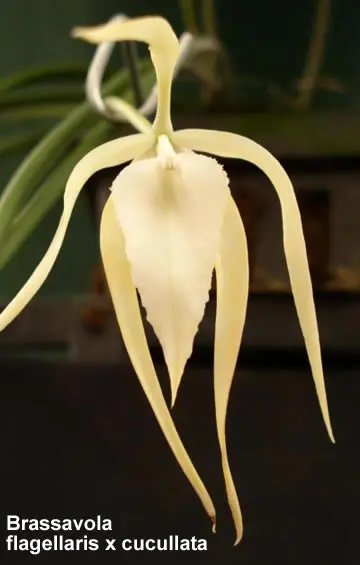 |
||
| Brassavola
This is a genus of seventeen species which can be found throughout much of the lowland American tropics. They have a single apical subterete leaf on a pencil like pseudobulb, the flowers are long lasting and highly fragrant at night, in order to attract the right moth. |
||
| Brassavola flagellaris x cucculata The orchid yields a single white or greenish white flower, or a raceme of a few flowers. The five greenish sepals are narrow and long. The base of the broad fringed lip enfolds partially the column. This column has a pair of falciform ears on each side of the front and contains twelve (sometimes eight) pollinia. The flower is scented in the evening. |
||
| /\ Top of Page | ||
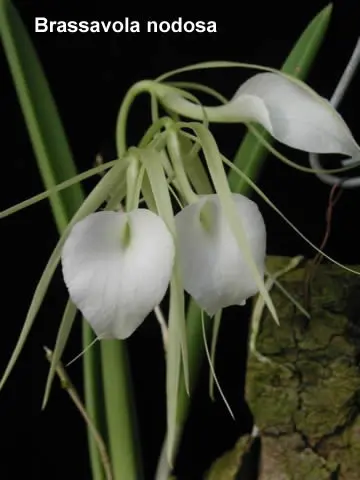 |
||
| Brassavola
This is a genus of seventeen species which can be found throughout much of the lowland American tropics. They have a single apical subterete leaf on a pencil like pseudobulb, the flowers are long lasting and highly fragrant at night, in order to attract the right moth. |
||
| Brassavola nodosa Distributed from Mexico to Colombia. The flowers are cream colored and have a heart shaped lip. The plant appreciate bright light and can be easily grown in an intermediate condition. The orchid flowers at various times of the year, generally winter to spring. |
||
| /\ Top of Page | ||
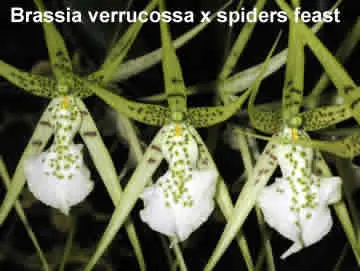 |
||
| Brassia
A genus of 29 species distributed throughout tropical South America. All easily cultivated at intermediate conditions.They are commonly called "The Spider Orchid" because of the flowers unique shape, the very elongate, spreading sepals and petals. The species are epiphyte, the pseudobulbs are about 7 to 15 cm with two to three leaves and carry from one to two inflorescens. |
||
| Brassia verrucosa x spider's feast Bright light yellow-green with brown marks over basal third. This is the only Brassia species that takes temperatures down to freezing. Summer blooming with fragrant flowers this species comes from Mexico to Northern Nicaragua. |
||
| /\ Top of Page | ||
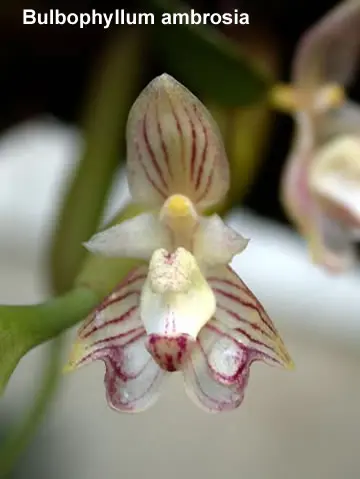 |
||
| Bulbophyllum
One of the largest genus which is divided into subgenera, some 1200 in total. Most of the species are from the cloud forests of south east Asia, in particular New Guinea, which is believed to be the center of distribution. |
||
| Bulbophyllum ambrosia A minature plant, the flowers are white, pink striped, on tall spikes. One of the few of this genus that has a pleasant fragrance - smells rather like honey, hence its name. Likes intermediate temps and moderate light |
||
| /\ Top of Page | ||
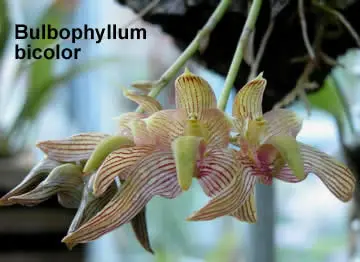 |
||
| Bulbophyllum
One of the largest genus which is divided into subgenera, some 1200 in total. Most of the species are from the cloud forests of south east Asia, in particular New Guinea, which is believed to be the center of distribution. |
||
| Bulbophyllum bicolor A species from china, Very attractive dark red-striped flowers, tan base color. Showy ciliate dorsal sepal. Has been the base species for many hybrids |
||
| /\ Top of Page | ||
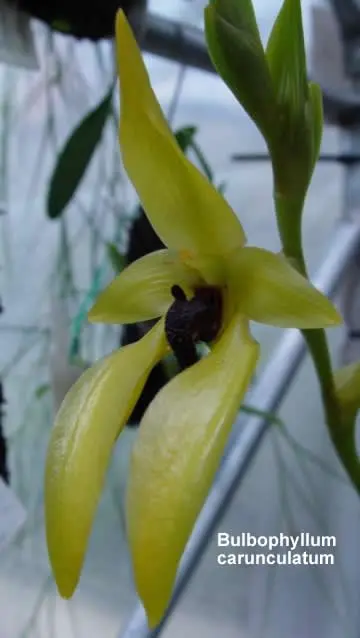 |
||
| Bulbophyllum
One of the largest genus which is divided into subgenera, some 1200 in total. Most of the species are from the cloud forests of south east Asia, in particular New Guinea, which is believed to be the center of distribution. |
||
| Bulbophyllum carunculatum x sulawesii | ||
| /\ Top of Page | ||
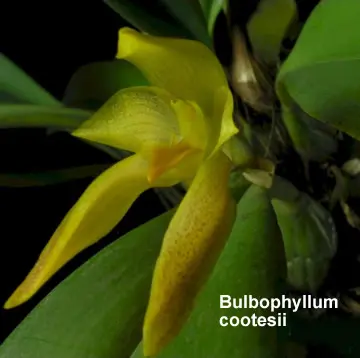 |
||
| Bulbophyllum
One of the largest genus which is divided into subgenera, some 1200 in total. Most of the species are from the cloud forests of south east Asia, in particular New Guinea, which is believed to be the center of distribution. |
||
| Bulbophyllum cootesii This orchid was only officially described in 1999 and named after the writer of "The Orchids of the Philippines", Jim Cootes, an Australian. Endemic to the island of Mindanao, the second largest and easternmost island in the Philippines. |
||
| /\ Top of Page | ||
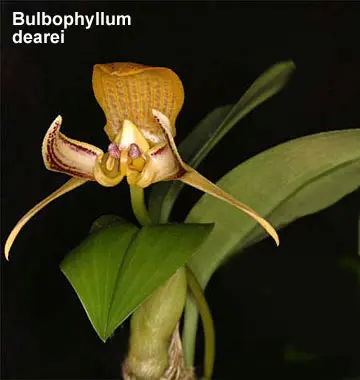 |
||
| Bulbophyllum
One of the largest genus which is divided into subgenera, some 1200 in total. Most of the species are from the cloud forests of south east Asia, in particular New Guinea, which is believed to be the center of distribution. |
||
| Bulbophyllum dearei A Philippines species, the spikes bear a single flower to 8 cm across, glossy yellow, the hinged lip is darker and the lateral sepals have a large red stripe. Give plenty of water and fertiliser when in growth, and it will tolerate a lot of sunlight which improves the flowering. A warm to intermediate grower. |
||
| /\ Top of Page | ||
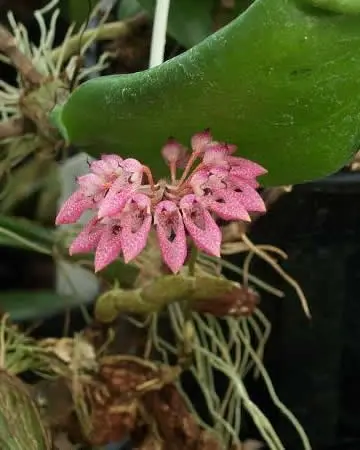 |
||
| Bulbophyllum
One of the largest genus which is divided into subgenera, some 1200 in total. Most of the species are from the cloud forests of south east Asia, in particular New Guinea, which is believed to be the center of distribution. |
||
| Bulbophyllum dentiferum No information on this species |
||
| /\ Top of Page | ||
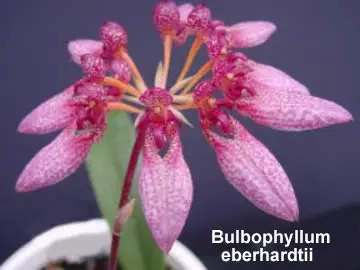 |
||
| Bulbophyllum
One of the largest genus which is divided into subgenera, some 1200 in total. Most of the species are from the cloud forests of south east Asia, in particular New Guinea, which is believed to be the center of distribution. |
||
| Bulbophyllum eberhardtii Known as Bulbophyllum longiflorum, this species is the most widely spread,it is distributed from Africa, the Philippines, Maluku, New Guinea, northern Australia, New Caledonia, Fiji, Tahiti and Guam. It likes warm to intermediate conditions. |
||
| /\ Top of Page | ||
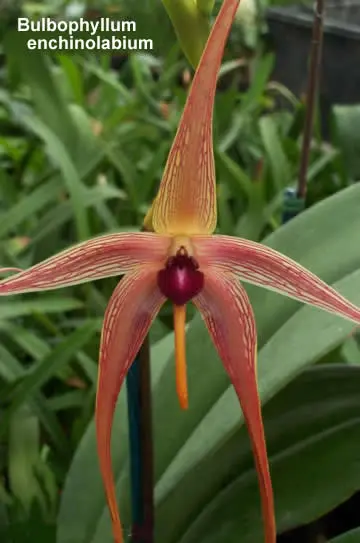 |
||
| Bulbophyllum
One of the largest genus which is divided into subgenera, some 1200 in total. Most of the species are from the cloud forests of south east Asia, in particular New Guinea, which is believed to be the center of distribution. |
||
| Bulbophyllum echinolabium Often measuring 30cm tall, these flowers bloom successively three to four times. Fragrant flowers that last about a week but the same inflorescense will produce flowers for over a month; Will bloom 3-4 times a year. Likes it humid, intermediate to warm temperatures with moderate light. |
||
| /\ Top of Page | ||
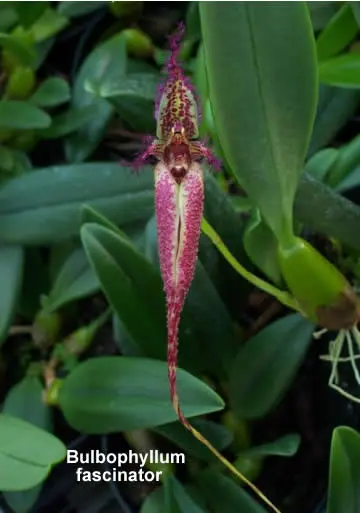 |
||
| Bulbophyllum
One of the largest genus which is divided into subgenera, some 1200 in total. Most of the species are from the cloud forests of south east Asia, in particular New Guinea, which is believed to be the center of distribution. |
||
| Bulbophyllum fascinator Native to Laos and Vietnam also known as Cirrhopetalum fascinator or Mastigion fascinator. It's a messed up world orchids! This fabulous orchid has long tails and electric purple hairs. |
||
| /\ Top of Page | ||